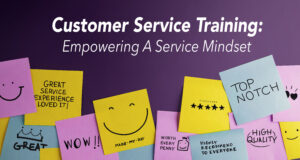Active Listening and A Questioning Mindset: A Powerful Combination

You won’t find out what customers value if you’re not listening and developing a questioning mindset that develops two-way conversations.
Whether you’re in a B2B industry or working directly with customers in a bank or other financial services, many businesses strive to understand what customers value. We know that building value for customers is how you ultimately earn their loyalty, but each customer is different. So, how do you find out what they value?
Well, you ask them.
Sounds easy enough, right?
But many professionals struggle with being proactive in engaging customers and asking meaningful questions. This might be due to lack of company or product knowledge, or simply a fear of damaging a relationship by coming across as an overly pushy product person.
Yet as customers, we often want to be engaged to explore our problems, desires or goals. In fact, effective sales and service professionals differentiate themselves by the quality of their questions. They bring value to us as customers when they get us to pause and think about what’s really important to us. We’ve all had those experiences where we think, “Wow, I’ve never thought about that. That’s a good question!”
How often do your sales or service professionals elicit that response? Let’s take a closer look at what it takes to bring out that “aha” moment for the customer to help them discover what their issues and challenges really are—and realize the opportunity cost of not acting.
All Sales Questions Aren’t Created Equal
Many sales and service professionals will tell you that they’re asking questions as part of their work process. But the kinds of questions and the attitude behind the questioning count. There’s a reason that some questions will draw out customer wants and needs while others can take you down a dead end.
Think about the difference between these two questioning attitudes:
- I want to ask you questions that will lead you and set you up for what I want to sell you.
- I want to ask you questions that will give me information so I can understand if you have wants or needs that I can help you fill or satisfy.
One set of questions can be manipulative, leading and close-ended. The other is sincere, unbiased and open-ended. The second set of questions doesn’t even have to be tied to a selling situation. It’s simply a way of making sure the customer’s needs are being met and value is being created at every opportunity.
The response to the first kinds of questions are often a quick yes or a no: “Do you need [xyz product]?” That doesn’t stimulate conversation. Need-development questions, on the other hand, get the customer talking.
At the Bank Trainers Conference we participate in annually, we ask participants in our sessions to brainstorm and list questions they might ask a customer or member who comes into their bank or credit union. Here are a few of the questions they will typically come up with:
- Tell me how you are saving for retirement?
- What do you like most about your savings account?
- How would you describe your ideal account?
- How do you save today?
- Have you thought about saving for college?
You can see how open-ended questions like these can take you deeper into a customer’s wants and needs. But I bet we could even improve on these. Here’s how we might take it a step further.
- If you achieve your retirement savings goal, what would that mean to you?
- How is your savings account of most benefit to you?
- I see you have several accounts with us, which of these are of greatest importance to you?
- What is the impact to your portfolio if you maintain your current savings path?
- If you could offer assistance to your children’s college fund, what would that mean to you?
Listening is Part of Asking Good Sales Questions
You won’t find out what someone values if you’re not listening. This seems like an obvious point, but active listening is a skill, and it’s one that often goes by the wayside when a salesperson is following a script or checking off mental boxes about what comes next or what product features they want to go over. This can be a common trap for inside sales or customer service professionals, particularly those who work off of call scripts.
Other salespeople can fall into the same trap too if they think they know what the customer’s wants or needs. By making assumptions of a customer’s needs, premature presentations are made that are often met with resistance or objections. Think about if a doctor prescribed before diagnosis. They call that malpractice. Until you have fully diagnosed the situation, you can’t prescribe a solution. We all know what it feels like when someone recommends a solution before diagnosing our needs. When salespeople do this, it’s an injustice to your customers and could be pushing them away.
It’s worth noting, too, that there’s more to questioning than just learning a customer’s wants and needs. In fact, the more the customer talks and the more the sales or service professional actively listens, the more at ease the customer is, which elevates the trust level in the relationship. And it’s also more likely that the customer will recognize their problem and clamor for a solution.
Developing the Questioning Mindset
In a metric-driven organization, the focus is on hitting the desired milestones, and of course, they’re critical. But that emphasis is often what makes people uncomfortable asking questions. Because they’re focused on selling X number of products or Y number of services, they default to those close-ended, leading questions that put them in the position of manipulative product-pusher—a position no one wants to be in, and the reason many have such a poor view of selling.
In financial institutions, the counter’s gone away and we have universal bankers. In just about every industry, customers know more about your products and services before they ever engage with you. That means customer-facing teams need to be equipped and motivated to find out what their needs are and learn about other challenges.
Asking “Do you need a Visa?” doesn’t lead you to a place where you’re going to uncover needs, and it doesn’t make the person asking the question feel like they’re in a role that creates value for their customers. Asking “What do you like best about the credit card you carry now”, or “Is there anything you’d like to see in a credit card that you’re not currently getting?” creates a two-way conversation that shows the customer you care about them and their experience.
Yes, you have to meet the metrics, but there’s a better way to come at it and to achieve those.

Vice President, Client Development
Related Blog Posts



